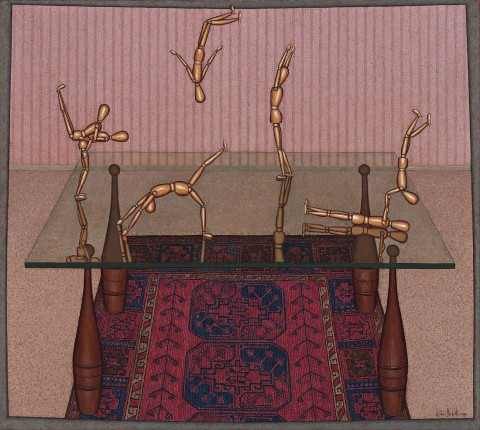THE TUMBLERS, 1990
JOHN BRACK
oil on canvas
122.0 x 137.0 cm
signed and dated lower right: John Brack 1990
inscribed with date and title on artist’s label verso
Rex Irwin Art Dealer, Sydney (label attached verso)
Private collection, Sydney
John Brack Recent Paintings and Drawings, Rex Irwin Art Dealer, Sydney, 13 April – 1 May 1993, cat. 5 (illus. on exhibition invitation)
John Brack’s 75th Birthday Exhibition, Rex Irwin Art Dealer, Sydney, 23 May – 10 June 1995, cat. 6
Grishin, S., The Art of John Brack, Oxford University Press, Melbourne, 1990, vol. II, cat. o313, p. 40
The Tumblers, 1990, watercolour on paper, private collection, Melbourne, in Grishin, S., The Art of John Brack, Oxford University Press, Melbourne, 1990, vol. II, cat. p312, p. 74
John Brack is renowned as the artist who most succinctly captured the character of twentieth century Australian life. His iconic paintings including The bar, 1954, Collins St, 5p.m., 1955 (both National Gallery of Victoria, Melbourne), and the ballroom dancing series of the late 1960s are eternally popular with successive generations of viewers and now more than fifty years on, also tinged with nostalgia for our recent past.
While Brack’s imagery was often interpreted as satirical social commentary, his primary motivation was quite different. As he explained, ‘What I paint most is what interests me most, that is, people; the Human Condition … A large part of the motive … is the desire to understand, and if possible, to illuminate … My material is what lies nearest to hand, the people and the things I know best’.1 Throughout a career that spanned more than five decades Brack’s work evolved both stylistically and technically, as well as witnessing distinct changes of subject matter, however this focus on the human condition remained a consistent and primary theme.
Ironically, in the mid-1970s the human figure disappeared almost entirely from Brack’s imagery, replaced in ensuing series by various inanimate objects, from museum postcards, umbrellas, pens, pencils and playing cards, to wooden artists’ manikins and Pinocchio dolls. Using these everyday props to construct subtle visual metaphors, Brack’s new approach ‘[permitted] him to express the whole complexity of social interconnections’2 and his perspective on the perennial forces of human nature was transformed from the local to a broader universal view.
Brack turned seventy in 1990 and many of the works made around this time show the artist reflecting on his own experience of life as well as looking forward. As Helen Brack recalled, ‘John was getting older, and so he was starting to think of the future – not his future but the future … (He realised) that it was the same again – we’d very much seen this, been there. That was the beginning of his making an image for perpetuation … There is an optimism at the end of John’s life that wasn’t there earlier’.3 In this context the acrobatic manikins that leap and somersault across the picture in Tumblers, 1990 reflect the carefree confidence, energy and freedom of youth. Their placement on a sheet of glass resting on wooden juggling pins introduces an unsettling note however, highlighting the precariousness of the situation and the critical role that each figure plays in maintaining balance and flow. How better to depict the interdependence of individuals within any community? Pictured in an enclosed domestic space against a backdrop of subdued striped wallpaper and flecked carpet, the scene is at once intimate and familiar while the intricate pattern and strong colour of the Persian carpet (an often-used motif in Brack’s work from the 1950s on) pushes it out into the world making it an image and associated lesson that is relevant to all.
From the depiction of the patterned carpet to the reflections of the manikins in the glass, Tumblers reveals the extraordinary level of detail and meticulous finish that typifies Brack’s late paintings. Beginning with a series of preliminary sketches, Brack would construct a ‘stage-set’ in his studio and after settling on the final composition, made a carefully detailed watercolour as a guide. Embarking on the oil painting, he employed various aids including stencils and tracings, as well as ‘a particular commercial medium that made possible the finest lines of an 00 sable brush, or a flick, using paint as if it were on the fine point of a pen.’4
1. Brack, J., quoted in Reed, J., New Painting 1952-62, Longman, Melbourne, 1963, p. 19
2. Grishin, S., The Art of John Brack, Oxford University Press, Melbourne, 1990, p. 140
3. Brack, H., quoted in Gott, T., A Question of Balance: John Brack 1974 – 1994, exhibition catalogue, Heide Museum of Modern Art, Victoria, 2000, p. 34
4. ibid., p. 18. See also for more detail regarding Brack’s process.
KIRSTY GRANT
